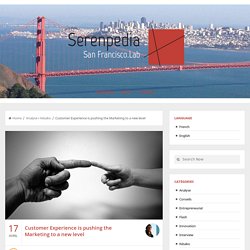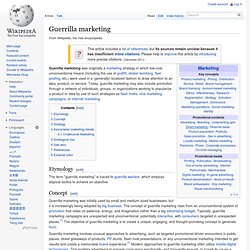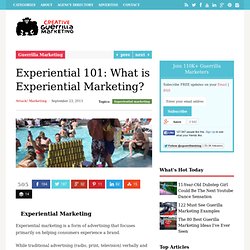

Branded content. Branded content is a relatively new form of advertising medium that blurs conventional distinctions between what constitutes advertising and what constitutes entertainment.

Branded content is essentially a fusion of the two into one product intended to be distributed as entertainment content, albeit with a highly branded quality. Customer Experience is pushing the Marketing to a new level. The role of marketing and communications in client experience is often underestimated, or even completely misunderstood.

This article defines “Augmented Connection” and its implications for client experience, which pushes marketing to become more original and creative. ► The Rise of Augmented Connection One of the objectives of communications has always been to create, in the target audience, a positive feeling towards a product/service or its brand. With the development of direct marketing, then the rise of social networks, brands are directly engaging in dialogue with their consumers: the connection is created. Today, through this connection, brands are looking to gain the esteem of their clients, even “Brand Love”. What one must comprehend is that customer experience has taken centre stage.
In the search for buzz and “going viral”, marketing has become more and more digital (digital reality, digital utility, digital culture) . ► Brand Utility: The Offline Pillar of Augmented Connection. A useful guide to the brand utility. Marketing Agencies Association partner zone. Brand activation: An increasingly curious term actively touted by two familiar parties; clients - who more often than not use it to define the activity they're spending their Ad-pounds on; and also by some agencies, who use it as a positioning statement when asked 'so what does your agency do?

' But what does the term actually mean in a world that is experiencing media convergence at a rate of knots and with many brands struggling to execute truly integrated campaigns, based upon a singular, insightful, organising thought? We've found ourselves in a world cluttered with meaningless content. Tactical experiential activity that lacks any strategic consideration and endless social media campaigns that are still finding their way, picking up the occasional 'like' or 're-tweet'. Where is the commercial return and what is this contributing towards the equity of the brands they represent? Guerrilla marketing. Guerrilla marketing was originally a marketing strategy in which low-cost, unconventional means (including the use of graffiti, sticker bombing, flyer posting, etc.) were used in a (generally) localized fashion to draw attention to an idea, product, or service.

Today, guerrilla marketing may also include promotion through a network of individuals, groups, or organizations working to popularize a product or idea by use of such strategies as flash mobs, viral marketing campaigns, or internet marketing. Etymology[edit] The term "guerrilla marketing" is traced to guerrilla warfare, which employs atypical tactics to achieve an objective. Concept[edit] Strategy[edit] The guerrilla marketing promotion strategy was first identified by Jay Conrad Levinson in his book Guerrilla Marketing (1984).[1] The book describes hundreds of "guerrilla marketing weapons" in use at the time. Street marketing. Street marketing is marketing or promoting products or services in an unconventional way in public places.[1][2] The main point of street marketing is that the activities are done exclusively on the streets or other public places, such as shopping centers.[3] Unlike typical public marketing campaigns that utilize billboards, street marketing involves the application of multiple techniques and practices in order to establish direct contact with the customers.[3][4] One of the goals of this interaction is to cause an emotional reaction in the clients.[3] The final goal of street marketing is to get people to remember brands in a different way than they are used to.[1] Origin[edit] This marketing technique started by the need of businesses,especially small businesses,[1] to attract customers rather than wait for them to come, using alternative methods for the diffusion of their brand names.

Experiential 101: What is Experiential Marketing? Experiential Marketing Experiential marketing is a form of advertising that focuses primarily on helping consumers experience a brand.

While traditional advertising (radio, print, television) verbally and visually communicates the brand and product benefits, experiential marketing tries to immerse the consumers within the product by engaging as many other human senses as possible. In this way, experiential marketing can encompass a variety of other marketing strategies from individual sampling to large-scale guerrilla marketing. In the end, the goal of experiential marketing is to form a memorable and emotional connection between the consumer and the brand so that it may generate customer loyalty and influence purchase decision. History and Development: As B. What is Ambient Advertising? 326 SharesTwitter119Facebook102Google+9Pin It Share63LinkedIn32StumbleUpon1326 Flares× Ambient advertising is about placing ads on unusual items or in unusual places you wouldn’t normally see an ad.

An ambient ad doesn’t have to be placed outside. Ambient advertising can be found anywhere and everywhere! The key to a successful ambient media campaign is to choose the best media format available and combined with effective message. These kinds of ads often make someone think about a certain place or thing differently. A common trend we see in ambient advertising is taking an object and making it in larger or smaller scale. Scotch-Brite, a 3M group brand called on the agency Havas Sports & Entertainment, placed a large version of their product on the side of a building near the legendary Santiago Bernabeu stadium in Madrid. Credit: Paper Planes As we mentioned earlier, it’s not just about placing something unusual outside. So that’s ambient advertising. Related. Prankvertising and 4 Other Ad Trends You Need to Know.
Want to make an impression with your next advertising campaign?

Try these trends that are working in a big way with consumers this year. May 23, 2014 Consumers are flooded with ads, offers, discounts and brand impressions. We are bombarded by tweets, Facebook ads, online ads and commercials during most radio and TV programming. Advertisers have learned that to get their messages out there—and cut through all the noise—they have to make an impression, a big one. A quick look at what's trending in advertising shows that bigger isn't always better, but different is better. Speedvertising Rather than trying to retrain viewers with increasingly short attention spans, some ads capitalize on the tendency—particularly among younger consumers—to ingest advertisements 140 characters at a time.
Sadvertising.